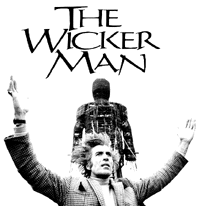
In Lugodoc's humble opinion, about a million times more stuff has been
written about the original, real iron-age druids than we will ever
actually know. The only fact
that we know about them for certain is that they were mysterious.
In an attempt to clear some very muddied waters, below I have collected every surviving word written down about the druids by the classical writers of chronicals up to A.D. 350. Everything written after this date (and even much before it) is pure speculation. All bold emphasis is by this author.
330 BC – Aristotle’s Treatise on Magic – Lost, possibly apocryphal, but referred to by Diogenes Laertius over 550 years later.
200 BC - Sotion of Alexandria’s Succession of Philosophers - Lost, but referred to by Diogenes Laertius over 400 years later.
70 BC – Poseidonius’ Chronicles – Lost, but used by his pupil Cicero about 30 years later.
50 BC - Julius Caesar’s The Conquest of Gaul, book VI
13. The two privileged classes are the Druids and
the knights. The Druids officiate at the worship of the gods,
regulate public and private sacrifices,
and give rulings on all religious questions. Large numbers
of young men
flock to them for instruction, and they are held in great honour
by the
people. They act as judges in practically all disputes, whether
between tribes or between individuals; when any crime is committed, or
a murder takes place, or a dispute arises about an inheritance or a
boundary, it is they who adjudicate the matter and appoint the
compensation to be paid and received by the parties concerned. Any
individual or tribe failing to accept their award is banned from
taking
part in sacrifice - the heaviest punishment that can be inflicted
upon
a Gaul. Those who are laid under such a ban are regarded as impious
criminals. Everyone shuns them and avoids going near or speaking to
them, for fear of taking some harm by contact with what is unclean; if
they appear as plaintiffs, justice is denied them, and they are
excluded from a share in any honour. All the Druids are under one
head,
whom they hold in the highest respect. On his death, if any one of the
rest is of outstanding merit, he succeeds to the vacant place; if
several have equal claims, the Druids usually decide the election by
voting, though sometimes they actually fight it out. On
a fixed
date in each year they hold a session in a consecrated spot in the
country of the Carnutes, which is supposed to be the centre of Gaul.
Those who are involved in disputes assemble here from all parts, and
accept the Druids' judgements and awards. The Druidic doctrine is
believed to have been found existing in Britain and thence
imported into Gaul; even today those who want to make a profound study
of it generally go to Britain for the purpose.
14. The Druids are exempt from military service and do not pay taxes like other citizens. These important privileges are naturally attractive: many present themselves of their own accord to become students of Druidism, and others are sent by their parents or relatives. It is said that these pupils have to memorize a great number of verses - so many, that some of them spend twenty years at their studies. The Druids believe that their religion forbids them to commit their teachings to writing, although for most other purposes, such as public and private accounts, the Gauls use the Greek alphabet. But I imagine that this rule was originally established for other reasons - because they did not want their doctrine to become public property, and in order to prevent their pupils from relying on the written word and neglecting to train their memories; for it is usually found that when people have the help of texts, they are less diligent in learning by heart, and let their memories rust.
A lesson which they take particular pains to inculcate is that the soul does not perish, but after death passes from one body to another; they think that this is the best incentive to bravery, because it teaches men to disregard the terrors of death. They also hold long discussions about the heavenly bodies and their movements, the size of the universe and of the earth, the physical constitution of the world, and the power and properties of the gods; and they instruct the young men in all these subjects.
16. As a nation the Gauls are extremely superstitious; and so persons suffering from serious diseases, as well as those who are exposed to the perils of battle, offer, or vow to offer, human sacrifices, for the performance of which they employ Druids. They believe that the only way of saving a man's life is to propitiate the god's wrath by rendering another life in its place, and they have regular state sacrifices of the same kind. Some tribes have colossal images made of wickerwork, the limbs of which they fill with living men; they are then set on fire, and the victims burnt to death. They think that the gods prefer the execution of men taken in the act of theft or brigandage, or guilty of some offence; but when they run short of criminals, they do not hesitate to make up with innocent men.
17. The god they reverence most is Mercury. They have very many images of him, and regard him as the inventor of all arts the god who directs men upon their journeys, and their most powerful helper in trading and getting money. Next to him they reverence Apollo, Mars, Jupiter, and Minerva, about whom they have much the same ideas as other nations - that Apollo averts illness, and Minerva teaches the principles of industries and handicrafts- that Jupiter is king of the gods, and Mars the lord of war. When they have decided to fight a battle they generally vow to Mars the booty that they hope to take, and after a victory they sacrifice the captured animals and collect the rest of the spoil in one spot. Among many ot the tribes, high piles of it can be seen on consecrated ground-and it is an almost unknown thing for anyone to dare, in defiance of religious law, to conceal his booty at home or to remove anything placed on the piles. Such a crime is punishable by a terrible death under torture.
18. The Gauls claim all to be descended from Father Dis declaring that this is the tradition preserved by the Druids. For this reason they measure periods of time not by days but by nights - and in celebrating birthdays, the first of the month, and new year's day, they go on the principle that the day begins at night.
21. The customs of the Germans are entirely different. They have no druids to control religious observations and are not much given to sacrifices.
36 BC - Cicero’s De Divinatione
I, XLI, 90: Nor is the
practice of divination disregarded even among uncivilised tribes, if
indeed there are Druids in Gaul - and there are, for I knew one of them
myself, Divitiacus, the Aeduan, your guest and eulogist. He claimed to
have that knowledge of nature which the Greeks call “physiologia”, and
he used to make predictions, sometimes by means of augury and
sometimes by means of conjecture.
8 BC - Diodorus Siculus’Histories
V, 28, 6 The Pythagorean doctrine prevails among them (the Gauls),
teaching that the souls of men are immortal and live again for a fixed
number of years inhabited in another body.
V, 31, 2-5 And there are among them (the Gauls) composers of verses whom they call Bards; these singing to instruments similar to a lyre, applaud some, while they vituperate others. They have philosophers and theologians who are held in much honour and are called Druids ; they have sooth-sayers too of great renown who tell the future by watching the flights of birds and by observation of the entrails of victims; and every one waits upon their word. When they attempt divination upon important matters they practice a strange and incredible custom, for they kill a man by a knife-stab in the region above the midriff, and after his fall they foretell the future by the convulsions of his limbs and the pouring of his blood, a form of divination in which they have full confidence, as it is of old tradition. It is a custom of the Gauls that no one performs a sacrifice without the assistance of a philosopher, for they say that offerings to the gods ought only to be made through the mediation of these men, who are learned in the divine nature and, so to speak, familiar with it, and it is through their agency that the blessings of the gods should properly be sought. It is not only in times of peace, but in war also, that these seers have authority, and the incantations of the bards have effect on friends and foes alike. Often when the combatants are ranged face to face, and swords are drawn and spears bristling, these men come between the armies and stay the battle, just as wild beasts are sometimes held spellbound. Thus even among the most savage barbarians anger yields to wisdom, and Mars is shamed before the Muses.
AD 10 – Strabo’s Geographies
IV, 4, c. 197, 41 Among
all the Gallic peoples, generally speaking, there are three sets of men
who are held in exceptional honour: the Bards, the Vates, and the
Druids. The Bards are
singers and poets; the Vates, diviners and natural
philosophers; while the Druids, in addition to natural
philosophy,
study also moral philosophy. The Druids are considered the most
just of
men, and on this account they are entrusted with the decision, not
only
of the private disputes, but of the public disputes as well; so that,
in former times, they even arbitrated cases of war and made the
opponents stop when they were about to line up for battle, and the
murder cases in particular, had been turned over to them for decision.
Further, when there is a big yield (of criminals for sacrifice) from
these cases, there is forthcoming a big yield from the land too, as
they think. However, not only the Druids, but others as well, say that
men's souls, and also the universe, are indestructible, although
both
fire and water will at some time or other prevail over them.
IV, 4, c. 198, 5 But the Romans put a stop to these customs, as well as to all those connected with the sacrifices and divinations that are opposed to our usages. They used to strike a human being, whom they had devoted to death, in the back with a sabre, and then divine from his death-struggle. But they would not sacrifice without the Druids. We are told of still other kinds of human sacrifices; for example, they would shoot victims to death with arrows, or impale them in the temples, or having devised a colossus of straw and wood, throw into the colossus cattle and wild animals of all sorts and human beings, and then make a burnt offering of the whole thing.
AD 15 – Timagenes - Lost, but quoted by Ammianus Marcellinus over 300 years later.
AD 25 - Valerius Maximus
II, 6, 10 Having done with the
description of the town (Marseilles), an old custom of the Gauls may
now be mentioned ; for it is said that they lend to each other sums
that are repayable in the next world, so firmly are they convinced
that
the souls of men are
immortal. And I would call them foolish indeed, if it were not for the
fact that what these trousered barbarians believe is the very
faith of Greek Pythagoras himself.
When Julius Caesar invaded Britain in 55 and 54 BC as part of his invasion of Gaul, he had no interest in pacifying Celtic barbarians or bringing peace to Western Europe. What he really wanted was to destroy the Roman republic and make himself Emperor, and to do that he needed a very big army under his personal control, and to justify getting one of those he needed to find somewhere to invade "for the glory of Rome". And to justify that invasion he needed to present the European Celts as barbaric savages who needed to be brought under the "Pax Romana" both for the security of Rome and "for their own good". And to do that he needed to show that the Celts were a violent, barbarous people.
There are several references to human sacrifice,
but a careful reading suggests that these sacrifices were actually
carried out by the Gauls, that is to say the ordinary Gallic
population, and not specifically by their druid priests.Human sacrifice
seems to have been a common secular practise carried out by ordinary
men. It is stated that the druids were asked to officiate at
these sacrifices, but this does not mean that they were responsible for
them. Strabo says that "they <meaning the iron-age
Celts> would not sacrifice without the druids".
Which suggests that the druids were not performing the sacrifice.
Today in America Christian priests officiate at
executions, but does that make them executioners?
Caesar's description of The Wicker Man is not substantiated by a single piece of archeological evidence of any kind, and although Strabo mentions it as well he may just be copying Caesar. It is probably an outright lie, one of hundreds told by Caesar to help justify his invasion of Gaul.
Which is a shame, 'cos Lugodoc really digs...

Then came...
The great druid stronghold on Anglesey was attacked and
destroyed
under the command of the local British governer Suetonius Paulinus in
AD 61, and after this the druids ceased to have any official
existence.
Some survivors
fled to Ireland or Scotland, which were never conquered by Rome but
were conquered by Roman Christianity a few centuries later. Others
went underground and became wandering poets and storytellers, without
power or status. Their vast wealth of historical and metaphysical
knowledge faded into myth.
So after this, everything is just heresay, rumour and repetition, and just over another 2,000 words survive from the following 300 years...
AD 60 - Lucan’s Pharsalia
I, 450-8 And you, O Druids,
now that the clash of battle is stilled, once more have you returned to
your barbarous ceremonies and to the savage usage of your holy rites.
To you alone it is given to know the truth about the gods and deities
of the sky, or else you alone are ignorant of this truth. The innermost
groves of far-off forests are your abodes. And it is you who say
that
the shades of the dead seek not the silent land of Erebus and the pale
halls of Pluto; rather, you tell us that the same spirit has a body
again elsewhere, and that death, if what you sing is true, is but the
mid-point of long life.
AD 77 – Pliny’s Natural History
XVI, 249 Here we must
mention the awe felt for this plant by the Gauls. The Druids—for so
their magicians are called—held nothing more sacred than the mistletoe
and the
tree that bears it, always supposing that tree to be the oak.
But they choose groves formed of oaks for the sake of the tree
alone,
and they never perform any of their rites except in the presence of a
branch of it; so that it seems probable that the priests themselves may
derive their name from the Greek word for that tree. In fact, they
think that everything that grows on it has been sent from heaven and is
a proof that the tree was chosen by the god himself. The mistletoe,
however, is found but rarely upon the oak; and when found, is gathered
with due religious ceremony, if possible on the sixth day of the
moon (for it is by the moon that they measure their months and
years, and also their ages of thirty years).
They choose this day because the moon, though not yet in the middle of
her course, has already considerable influence. They call the mistletoe
by a name meaning, in their language, the all-healing. Having made
preparation for sacrifice and a banquet beneath
the trees, they bring thither two white bulls, whose horns are
bound
then for the first time. Clad in a white robe, the priest
ascends the tree and cuts the mistletoe with a golden sickle,
and it is received by others in a white cloak. Then they kill the
victims, praying that God will render this gift of his propitious to
those to whom he has granted it. They believe that the mistletoe, taken
in drink, imparts fecundity to barren animals, and that it is an
antidote for all poisons. Such are the religious feelings that are
entertained towards trifling things by many peoples.
XXIV, 103 Similar to savin is the plant called selago. It is gathered without using iron and by passing the right hand through the left sleeve of the tunic, as though in the act of committing a theft. The clothing must be white, the feet washed and bare, and an offering of wine and bread made before the gathering. The Druids of Gaul say that the plant should be carried as a charm against every kind of evil, and that the smoke of it is good for diseases of the eyes.
XXIV, 104 The Druids, also, use a certain marsh-plant that they call samolus, this must be gathered with the left hand, when fasting, and is a charm against the diseases of cattle. But the gatherer must not look behind him, nor lay the plant anywhere except in the drinking-troughs.
XXIX, 52 There is also another kind of egg, of much renown in the Gallic provinces, but ignored by the Greeks. In the summer, numberless snakes entwine themselves into a ball, held together by a secretion from their bodies and by their spittle. This is called anguinum. The Druids say that hissing serpents throw this up into the air, and that it must be caught in a cloak, and not allowed to touch the ground; and that one must instantly take to flight on horse-back, as the serpents will pursue until some stream cuts them off. It may be tested, they say, by seeing if it floats against the current of a river, even though it be set in gold. But as it is the way of magicians to cast a cunning veil about their frauds, they pretend that these eggs can only be taken on a certain day of the moon, as though it rested with mankind to make the moon and the serpents accord as to the moment of the operation. I myself, however, have seen one of these eggs; it was round, and about as large as a smallish apple; the shell was cartalaginous, and peeked like the arms of a polypus. The Druids esteem it highly. It is said to ensure success in law-suits and a favourable reception with princes ; but this is false, because a man of the Vocontii, who was also a Roman knight, kept one of these eggs in his bosom during a trial, and was put to death by the Emperor Claudius, as far as I can see, for that reason alone.
XXX, 13 It (magic) flourished in the Gallic provinces, too, even down to a period within our memory; for it was in the time of the Emperor Tiberius that a decree was issued against their Druids and the whole tribe of diviners and physicians. But why mention all this about a practice that has even crossed the ocean and penetrated to the utmost parts of the earth ? At the present day, Britannia is still fascinated by magic, and performs its rites with so much ceremony that it almost seems as though it was she who had imparted the cult to the Persians. To such a degree do peoples throughout the whole world, although unlike and quite unknown to one another, agree upon this one point. Therefore we cannot too highly appreciate our debt to the Romans for having put an end to this monstrous cult, whereby to murder a man was an act of the greatest devoutness, and to eat his flesh most beneficial.
AD 78 – Tacitus’ Annals (describing
the invasion of Anglesey in AD 61)
XIV, 30 On the shore stood the opposing army with its dense array of
armed warriors, while between the ranks dashed women in black attire
like the Furies, with hair
dishevelled, waving brands. All around, the Druids, lifting up
their
hands to heaven and pouring forth dreadful imprecations, scared our
soldiers by the unfamiliar sight, so that, as if their limbs were
paralysed, they stood motion-less and exposed to wounds. Then urged by
their general's appeal and mutual encouragements not to quail before a
troupe of frenzied women, they bore the standards onwards, smote down
all resistance and wrapped the foe in the
flames of his own brands. A force was next set over the conquered, and
their groves, devoted to inhuman superstitions, were destroyed.
They
deemed it, indeed, a duty to cover their altars with the blood of
captives and to consult their deities through human entrails.
AD 120 – Suetonius’ Claudius
25 He (the Emperor
Claudius) very thoroughly suppressed the barbarous and inhuman religion
of the Druids in Gaul, which in the time of Augustus had merely been
forbidden to Roman citizens.
AD 230 – Diogenes Laertius’ Lives of the Philosophers
intro
1: Some say that the study of philosophy was of barbarian origin. For
the Persians had their Magi, the Babylonians or the Assyrians the
Chaldeans, the Indians their Gymnosophists, while the Kelts and the
Galatae had seers called Druids and Semnotheoi or so
Aristotle says in
the " Magic," and Sotion in the twenty-third book of his " Succession
of Philosophers."
Vitce, intro 5: Those who think that philosophy is an invention of the barbarians explain the systems prevailing among each people. They say that the Gymnosophists and Druids make their pronouncements by means of riddles and dark sayings, teaching that the gods must be worshipped, and no evil done, and manly behaviour maintained.
AD 235 – Lampridius’ Alexander Severus
LIX, 5. While
he (Alexander Severus) was on his way, a Druidess cried out to
him in
the Gallic tongue, " Go forward, but hope not for victory, nor put
trust in thy soldiers."
AD 250 – Hippolytus’ Philosophumena
I, xxv 1 The
Keltic Druids applied themselves thoroughly to the Pythagorean
philosophy, being urged to this pursuit by Zamolxis, the slave of
Pythagoras, a Thracian by birth, who came to those parts after the
death of Pythagoras, and gave them opportunity of studying the system.
And the Kelts believe in their Druids as seers and prophets because
they can foretell certain events by the Pythagorean reckoning and
calculations. We will not pass over the origins of
their learning in silence, since some have presumed to make distinct
schools of the philosophies of these peoples. Indeed, the Druids
also
practice the magic arts.
AD 260 - Clement of Alexandria’s Stromala
I, xv, 70, I
Alexander, in his book "On the Pythagorean Symbols," relates that
Pythagoras was a pupil of Nazaratus the Assyrian, and will have it
that, in addition to these, Pythagoras
was a hearer of the Galatae and the Brahmins.
I, xv, 71, 3 1 Thus philosophy, a science of the highest utility, flourished in antiquity among the barbarians, shedding its light over the nations. And afterwards it came to Greece. First in its ranks were the pro-phets of the Egyptians ; and the Chaldeans among the Assyrians ; and the Druids among the Gauls ; and the Samanaeans among the Bactrians; and the philosophers of the Kelts; and the Magi of the Persians.
AD 275 – Vopiscus’ Numerianus
XIV When Diocletian, so
my grandfather told me, was sojourning in a tavern in the land of the
Tongri in Gaul, at the time when he was still of humble rank in the
army, and had occasion to settle the daily account for his keep with a
certain druidess,
this woman said to him, " You are far too greedy and far too
economical, O Diocletian." Whereto he replied, jestingly, " I will be
more liberal when I am emperor," to which the druidess answered, "
Laugh not,
Diocletian, for when you have killed The Boar, you will indeed be
emperor."
After this Diocletian coveted the purple and never missed the
chance of killing a boar when out hunting ; but Aurelian, and Probus
and Tacitus, and then Carus, were all emperors before him, so that he
was moved to exclaim, " I kill the boars, but it is always another who
reaps the reward ! " At last, however, he killed the prefect Arrius,
surnamed The Boar, and then the prophecy of the druidess was
fulfilled,
and he ascended to the imperial throne.
<editor's note: Diocletian
executed the praetorian prefect Arrius Aper for the murder of his
emperor and son-in-law Numerianus in A.D. 284, so how did Flavius
Vopiscus write this down in A.D. 275? It appears that Vopiscus was only
one of a group of authors of Roman history known as the Scriptores
Historiae Augustae (the writers of Augustan history) who wrote about
the emperors between A.D. 117
(Hadrian) and A.D. 284 (Carinus) and their work is suspected to
have been re-written under Constantine in around A.D. 330. More Roman
lies! >
AD 280 - Vopiscus’ Awelianus
XLIII, 4 and 5 He
(Asclepiodotus) used to say that on a certain occasion Aurelian
consulted the Gaulish druidesses to find out whether his descendants
would remain in possession of the imperial crown. These women told him
that no name would become more illustrious in the state
annals than that of the line of Claudius. It is true, of course, that
the present Emperor Constantius is of the same stock, and I think that
his descendants will assuredly attain to the glory foretold by the
druidesses.
<editor's note: Constantius
becames Augustus In The West in A.D. 305, so somebody has definitely
been re-writing history!>
AD 350 - Ammianus Marcellinus
XV, 9, 4 According to the
Druids, a part of the population (of Gaul) was indigenous, but some of
the people came from outlying islands and lands beyond the Rhine,
driven from their homes by repeated wars and by the inroads of the sea.
XV, 9, 8 In these regions, as the people gradually became civilised, attention to the gentler arts became commoner, a study introduced by the Bards, and the Euhages < sometimes written as ovates - ed>, and the Druids. It was the custom of the Bards to celebrate the brave deeds of their famous men in epic verse accompanied by the sweet strains of the lyre, while the Euhages strove to explain the high mysteries of nature. Between them came the Druids, men of greater talent, members of the intimate fellowship of the Pythagorean faith; they were up-lifted by searchings into secret and sublime things, and with grand contempt for mortal lot they professed the immortality of the soul.
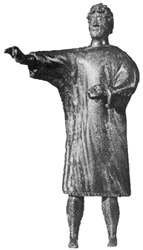 If the written accounts of druids are flimsy then the surviving
physical
evidence, the archaeology, is even weaker.
If the written accounts of druids are flimsy then the surviving
physical
evidence, the archaeology, is even weaker.
In spite of accounts of golden sickles, druid's eggs and giant
wicker men, nothing like these items has ever been dug up. Although
there are hundreds of surviving carvings, statues, coins and other
images depicting Celtic warriors, there is not one single definite
image of an iron age Celtic druid. Furthermore, although there are many
examples where the three main sources (history, archaeology and myth)
agree on how warriors looked and behaved, there are almost no examples
of even two of these sources agreeing on anything about druids.
The only object found thought to be
possibly an image of a druid is the Statue from The Sanctuary at
Neuvy-en-Sullias
- part of a vast hoard of treasure including many figurines. It is just
possibly a druid holding a druid’s egg, although it has no torc to
denote status or any other kind of possibly druidic attribute. Or it
might just
be a very relaxed charioteer.
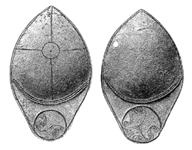 Archaeologists have also found several pairs
of
Spoons – these items are typically Southern British dating from
the first century BC and are
usually about 2 inches long. One is always engraved with a simple
cruciform pattern, the other punctured with a small hole.
Many pairs have been found at ritual sites (for example this pair from
Crosby Ravensworth) as opposed to normal domestic sites, and are
therefore assumed to be of ritual significance. There is no mention of
anything like them anywhere in the histories or the myths.
Archaeologists have also found several pairs
of
Spoons – these items are typically Southern British dating from
the first century BC and are
usually about 2 inches long. One is always engraved with a simple
cruciform pattern, the other punctured with a small hole.
Many pairs have been found at ritual sites (for example this pair from
Crosby Ravensworth) as opposed to normal domestic sites, and are
therefore assumed to be of ritual significance. There is no mention of
anything like them anywhere in the histories or the myths.
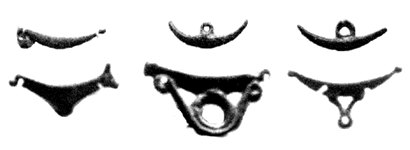 Another class of object, similarly
identified with iron age ritual sites, is the Grinder
– also typically Southern British. They are typically 2 to 3”
wide, and apparently designed to grind small quantities of something
and to be worn as a pendant. The British Museum has about twenty on
display, and if this many have survived for two thousand years then
many thousands must have been made and been in use. And yet,
again, there is no mention of them anywhere in the writings.
Another class of object, similarly
identified with iron age ritual sites, is the Grinder
– also typically Southern British. They are typically 2 to 3”
wide, and apparently designed to grind small quantities of something
and to be worn as a pendant. The British Museum has about twenty on
display, and if this many have survived for two thousand years then
many thousands must have been made and been in use. And yet,
again, there is no mention of them anywhere in the writings.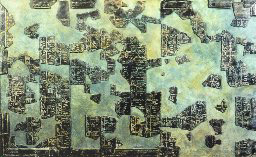 Somewhere
in the first century AD, after the druids started to use Latin to make
inscriptions but before they were outlawed, one group of druids created
the complex, mysterious and extremely expensive Coligny Calendar.
This huge bronze plate (5 ft x 3 ½ ft)
was made in a single piece but then broken up and buried. It covers 5
years and attempts
to reconcile lunar and solar observations. Each
month is 29 or 30 days long and covers exactly one cycle of the moon,
and is divided into a good half (waxing) and a bad half (waning). The
full moon (Atenoux) appears to be in the middle of each month.
Each year has 12 or 13 months.
Somewhere
in the first century AD, after the druids started to use Latin to make
inscriptions but before they were outlawed, one group of druids created
the complex, mysterious and extremely expensive Coligny Calendar.
This huge bronze plate (5 ft x 3 ½ ft)
was made in a single piece but then broken up and buried. It covers 5
years and attempts
to reconcile lunar and solar observations. Each
month is 29 or 30 days long and covers exactly one cycle of the moon,
and is divided into a good half (waxing) and a bad half (waning). The
full moon (Atenoux) appears to be in the middle of each month.
Each year has 12 or 13 months.
At least this object agrees with Pliny's comments on the druidic
measurements of time, but it is the only one of its kind ever found.
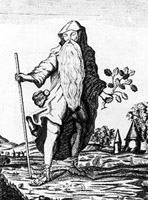
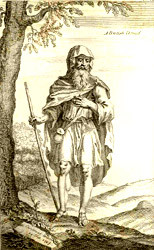 Just a little later
but far more famous was William Stukeley.
He was born in 1687, studied medicine and in 1718 he became the first
secretary of the Society of Antiquaries of London. He first visited
Stonehenge a year later and fell in love with it. He published the
results of his travels around Britain in his Itinerarium Curiosum
in 1724, and the results of his excavations at Stonehenge and
Avebury in Stonehenge, a Temple Restored to the British Druids
in 1740, and Abury, a Temple of the British Druids
three years later in 1743. His illustrations were heavily
influenced by, but even wackier than, Rowland's.
Just a little later
but far more famous was William Stukeley.
He was born in 1687, studied medicine and in 1718 he became the first
secretary of the Society of Antiquaries of London. He first visited
Stonehenge a year later and fell in love with it. He published the
results of his travels around Britain in his Itinerarium Curiosum
in 1724, and the results of his excavations at Stonehenge and
Avebury in Stonehenge, a Temple Restored to the British Druids
in 1740, and Abury, a Temple of the British Druids
three years later in 1743. His illustrations were heavily
influenced by, but even wackier than, Rowland's.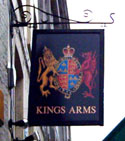

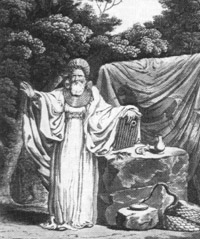 Inspite (or maybe even because)
of the English government oppression,
The Ancient Order of Druids continued to grow, spread, split and spawn
further neo-druidic
groups, and the nineteenth century is littered with them. Neo-druidic
societies were sprouting like mushrooms with names that would make
Monty Python proud, such as The Druid Church Of The Universal Bond, The
Circle Of The Universal Bond, The United Ancient Order Of Druids, The
Ancient Druid Order or even just The Order Of Druids. They mostly came
and went, but the AOD carried on through out the century. By 1815 the
commonly held opinion of what an iron age druid looked like had evolved
into the sorry drag act on the right.
Inspite (or maybe even because)
of the English government oppression,
The Ancient Order of Druids continued to grow, spread, split and spawn
further neo-druidic
groups, and the nineteenth century is littered with them. Neo-druidic
societies were sprouting like mushrooms with names that would make
Monty Python proud, such as The Druid Church Of The Universal Bond, The
Circle Of The Universal Bond, The United Ancient Order Of Druids, The
Ancient Druid Order or even just The Order Of Druids. They mostly came
and went, but the AOD carried on through out the century. By 1815 the
commonly held opinion of what an iron age druid looked like had evolved
into the sorry drag act on the right.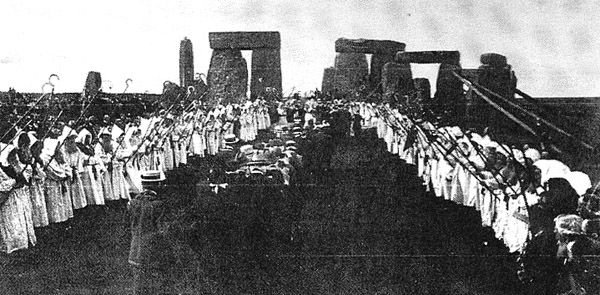
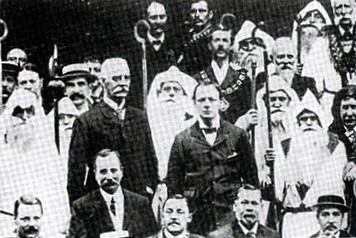
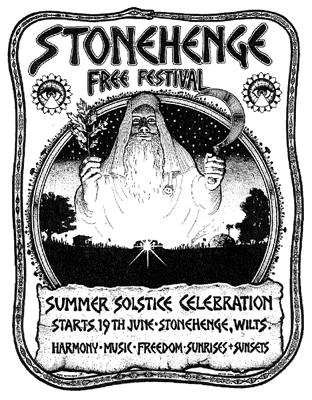
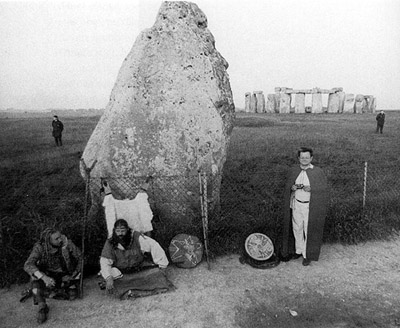 Every Summer solstice King Arthur would be at Stonehenge,
quietly and
peacefully asking to be allowed in, so that he could worship there. The
nearest he usually got was the chainlink fence at the Hele stone by the
A344 road that passes the monument. It was sitting there awaiting the
dawn in 1993 that he met a young shaman from Portsmouth called Dylan
Blight. The
exact moment is recorded in the photograph to the left, taken by a
press photographer. Dylan is seated at the left in dreadlocks and
Arthur is next to him in robes. (the man standing on the right is
Barnade, a French neo-druid who arrived with the press buss.) The
two
became lifelong friends, and at King Arthur's suggestion Dylan returned
home to create The Insular Order of Druids,
or IOD. He
didn't call it the Portsmouth Order of Druids because POD sounds silly.
This is the neo-druidical order that Lugodoc belongs to.
Every Summer solstice King Arthur would be at Stonehenge,
quietly and
peacefully asking to be allowed in, so that he could worship there. The
nearest he usually got was the chainlink fence at the Hele stone by the
A344 road that passes the monument. It was sitting there awaiting the
dawn in 1993 that he met a young shaman from Portsmouth called Dylan
Blight. The
exact moment is recorded in the photograph to the left, taken by a
press photographer. Dylan is seated at the left in dreadlocks and
Arthur is next to him in robes. (the man standing on the right is
Barnade, a French neo-druid who arrived with the press buss.) The
two
became lifelong friends, and at King Arthur's suggestion Dylan returned
home to create The Insular Order of Druids,
or IOD. He
didn't call it the Portsmouth Order of Druids because POD sounds silly.
This is the neo-druidical order that Lugodoc belongs to.